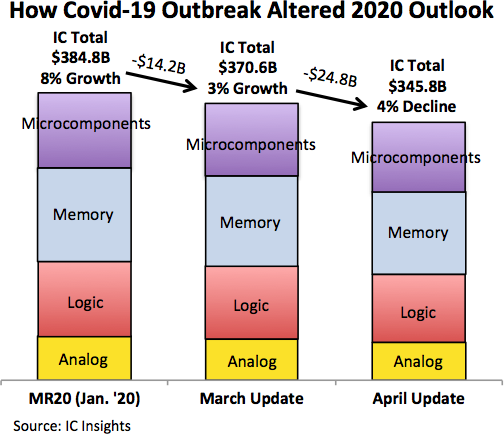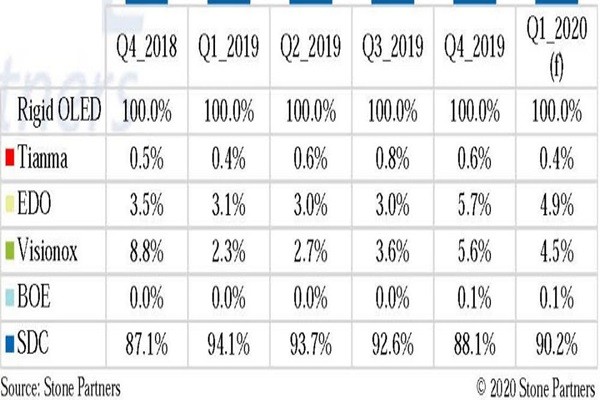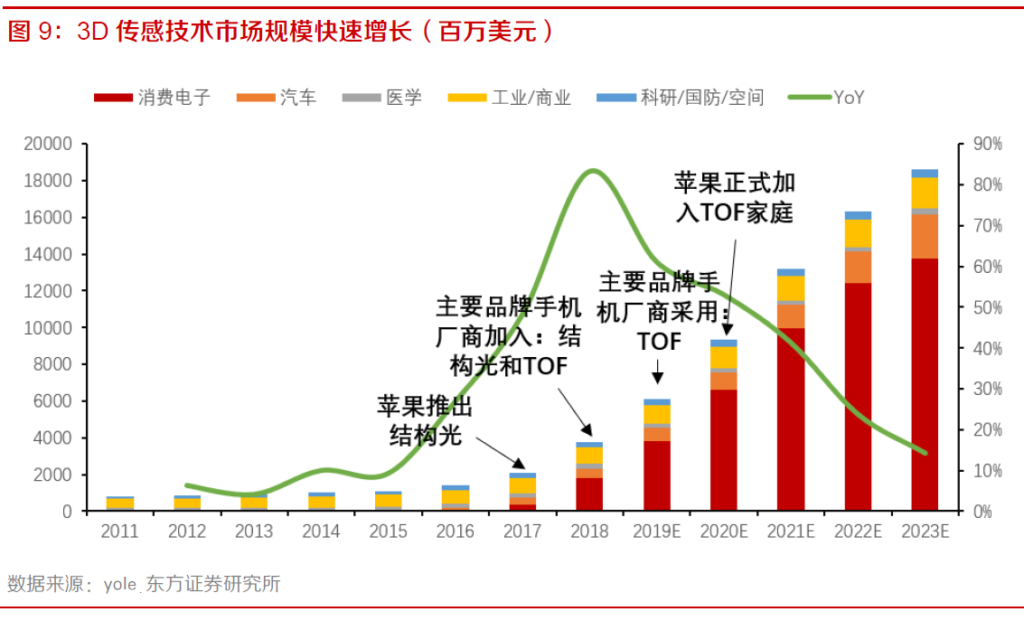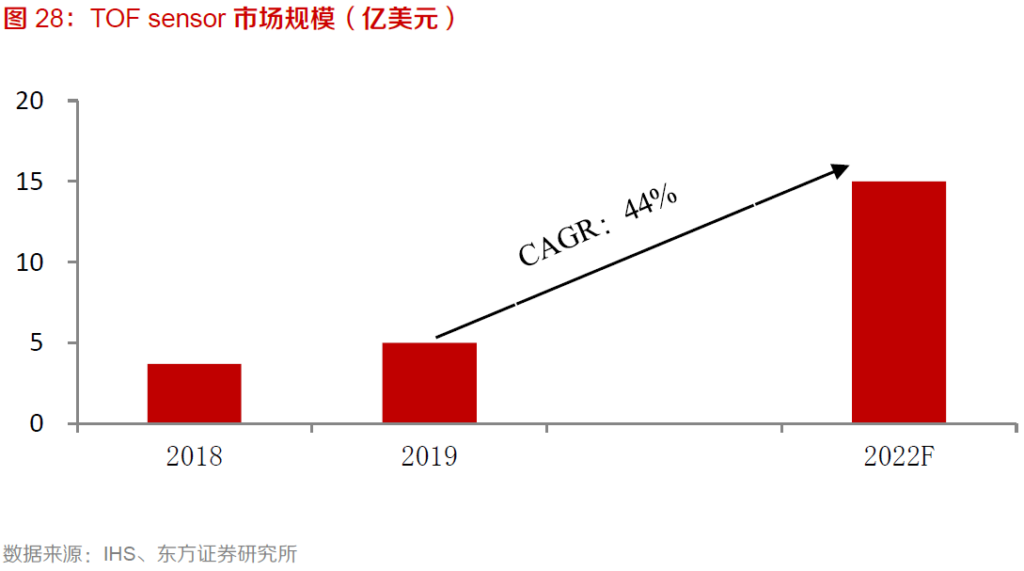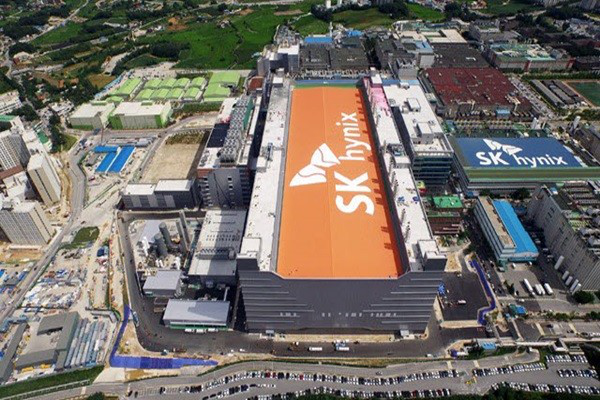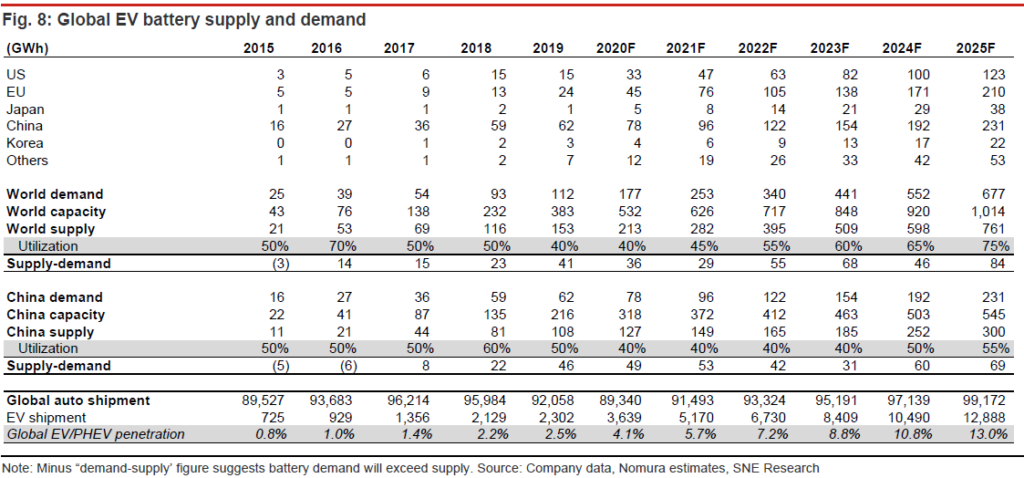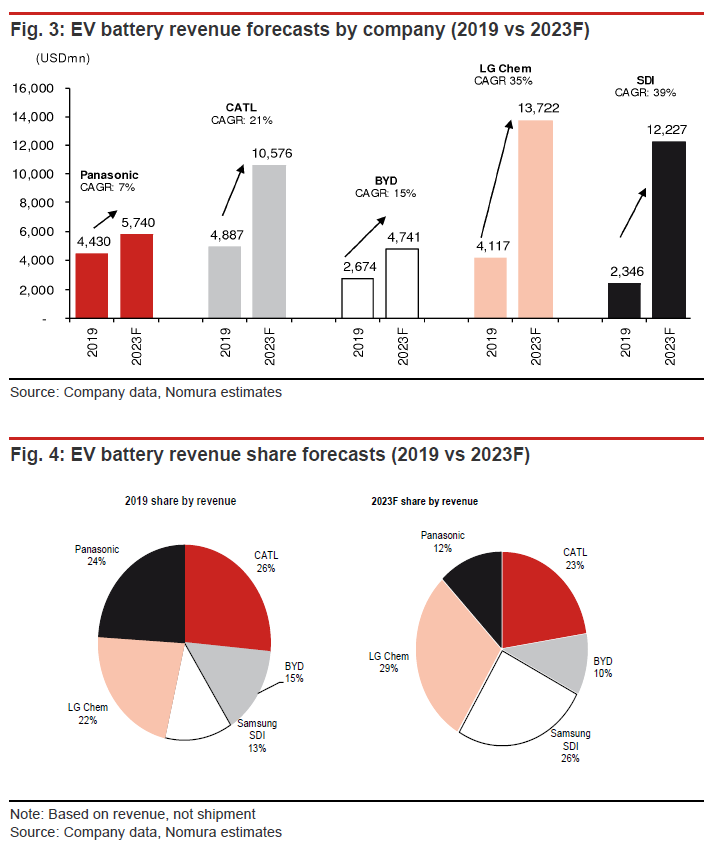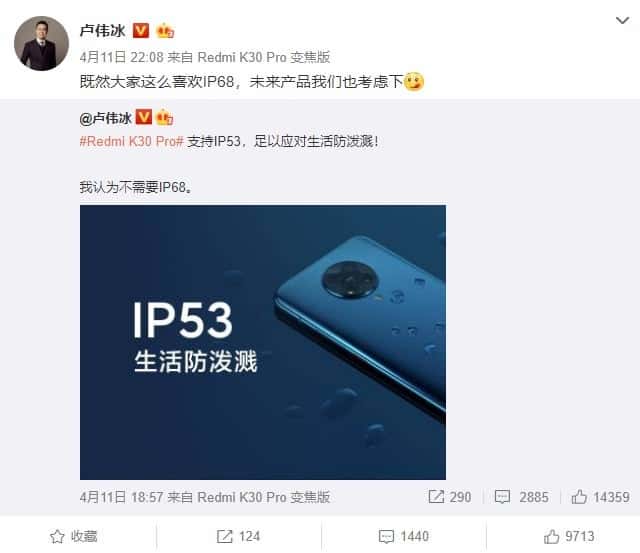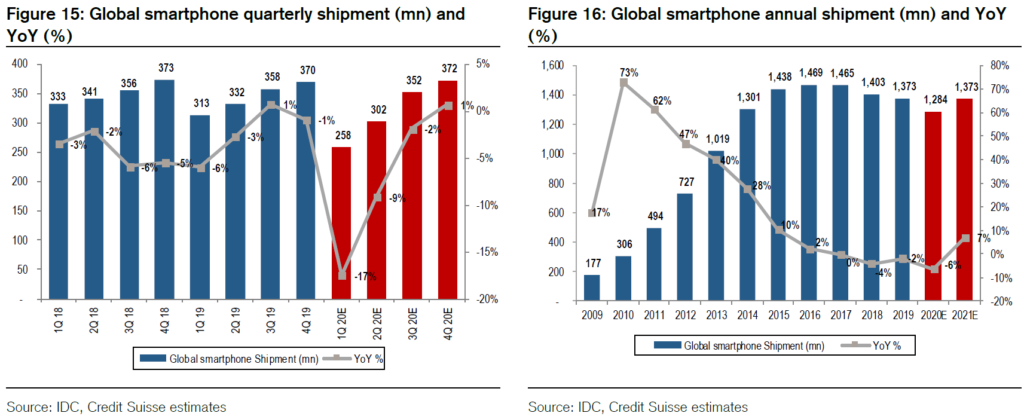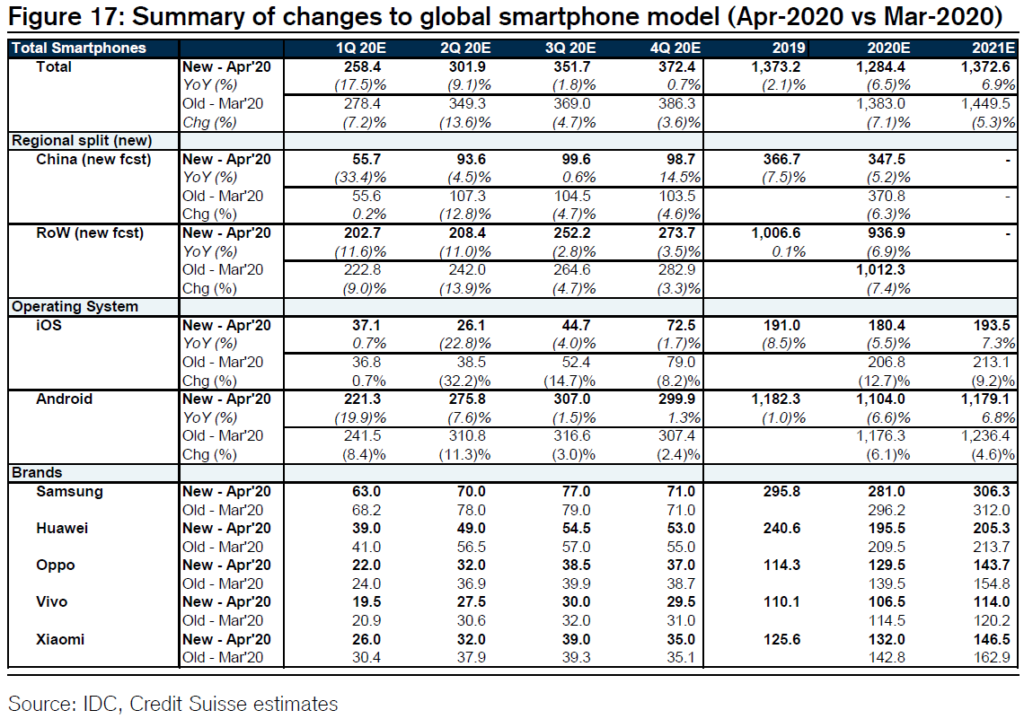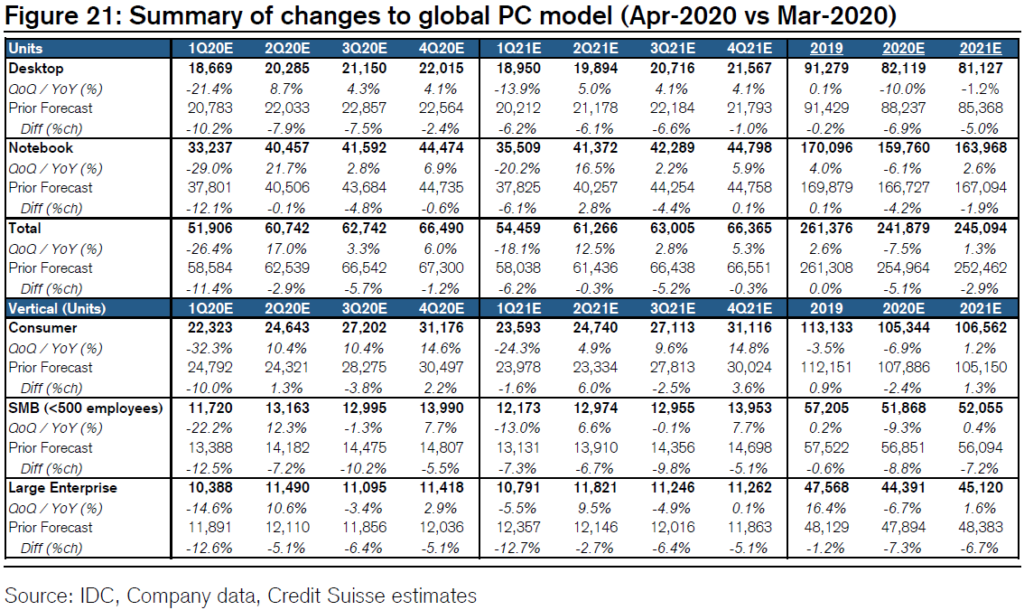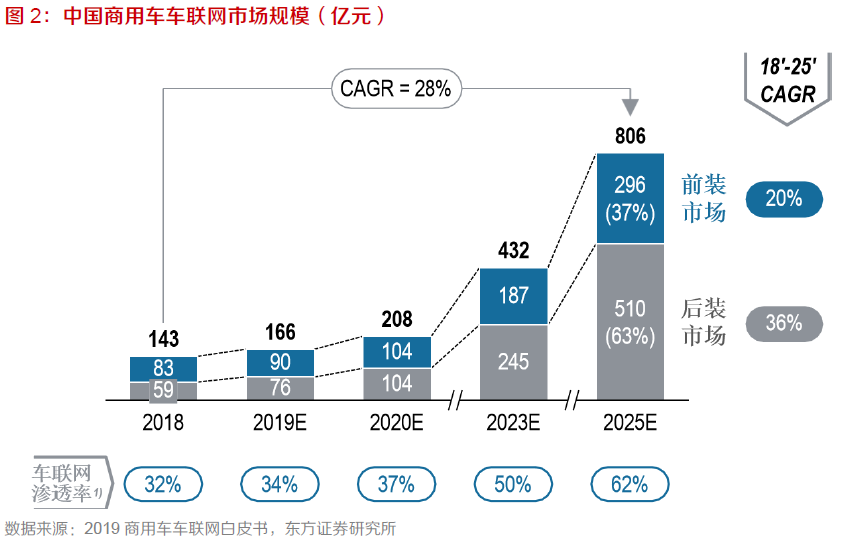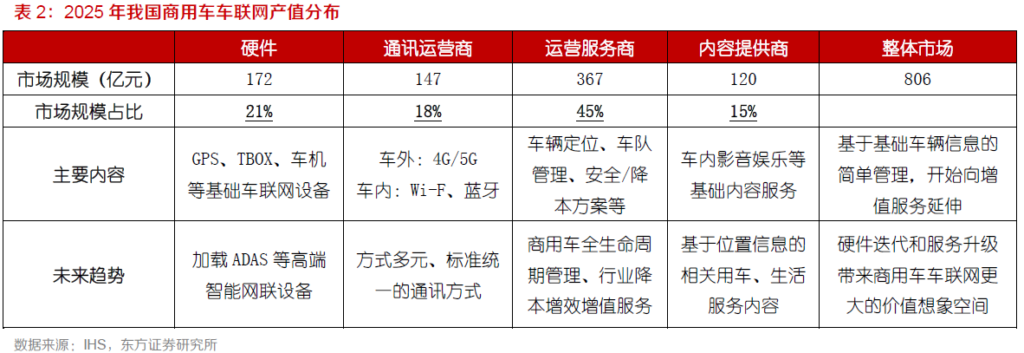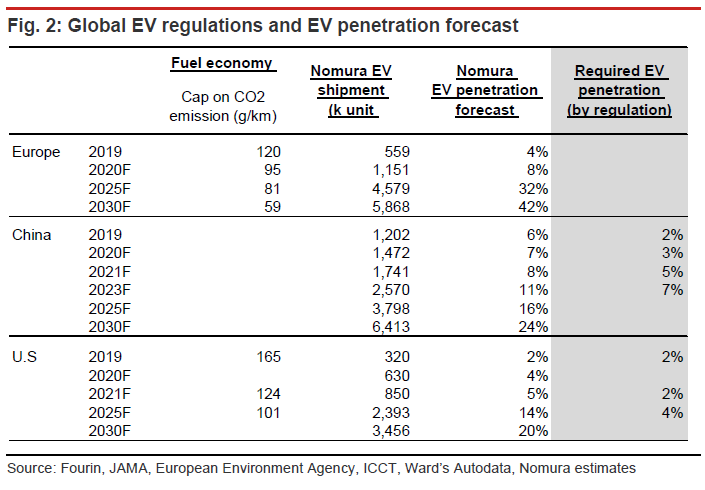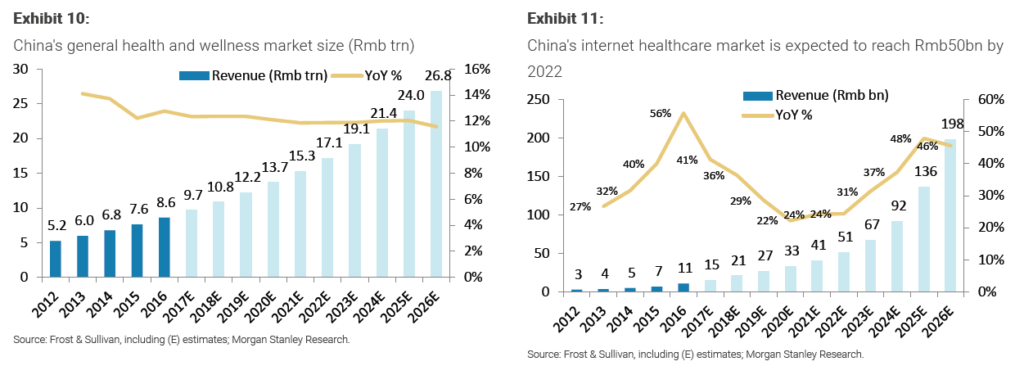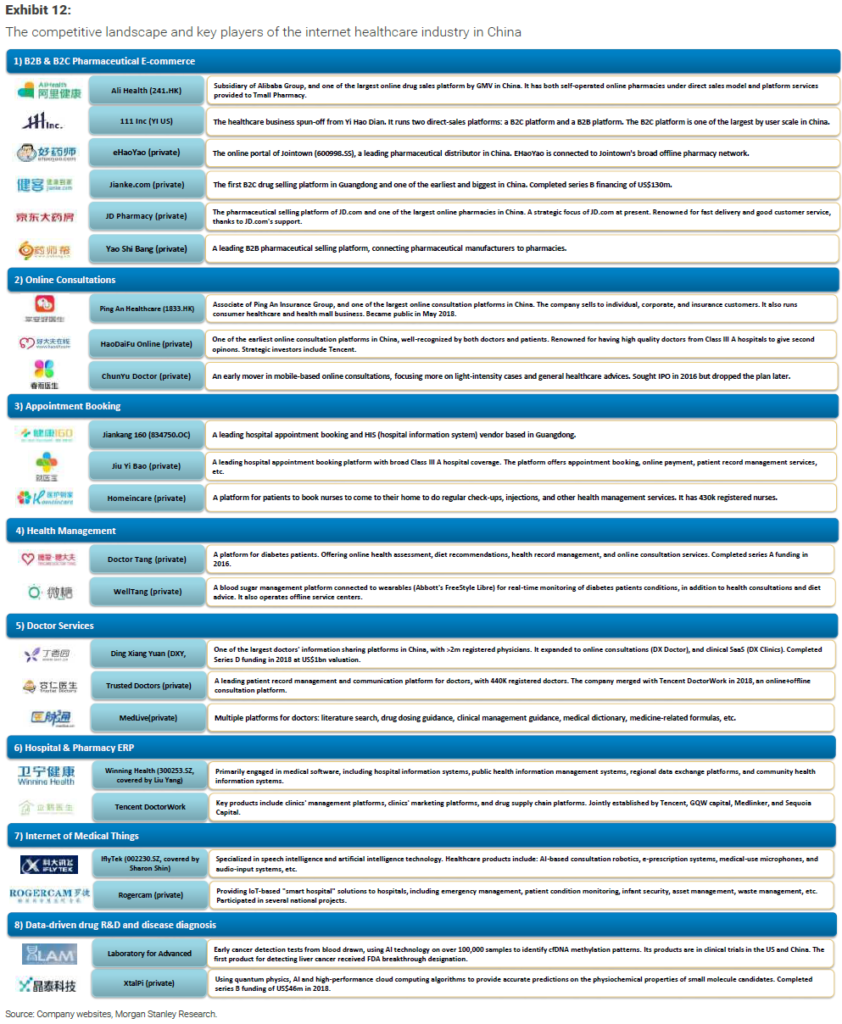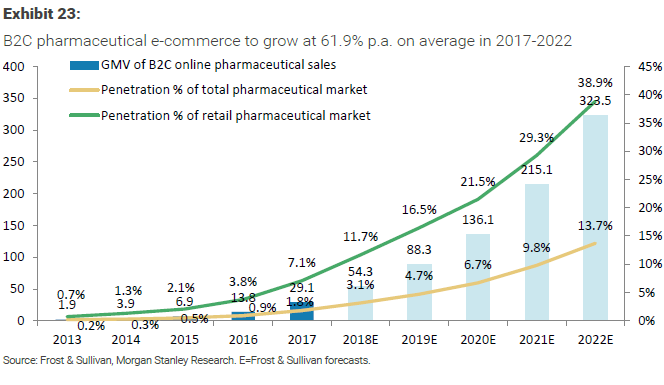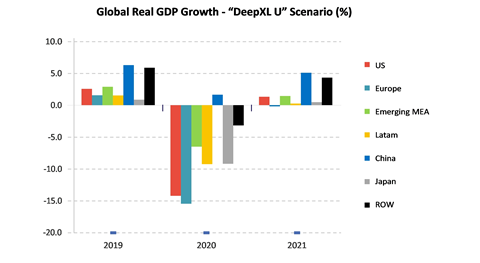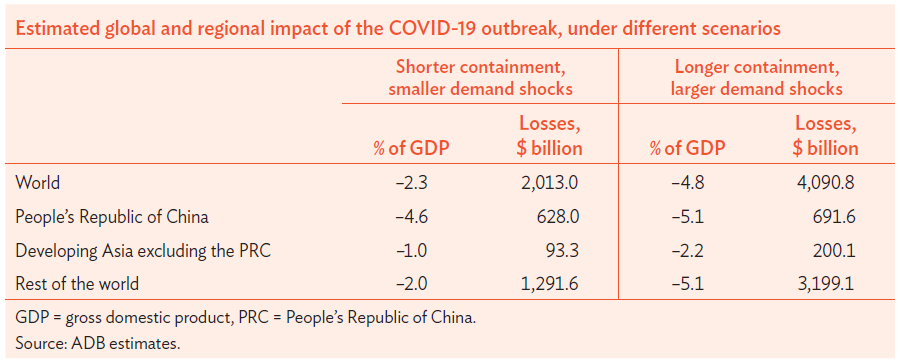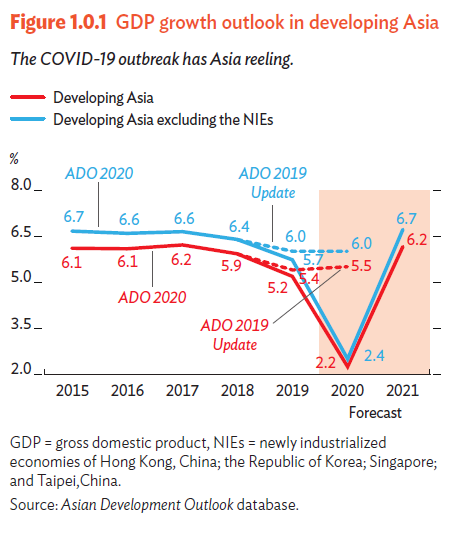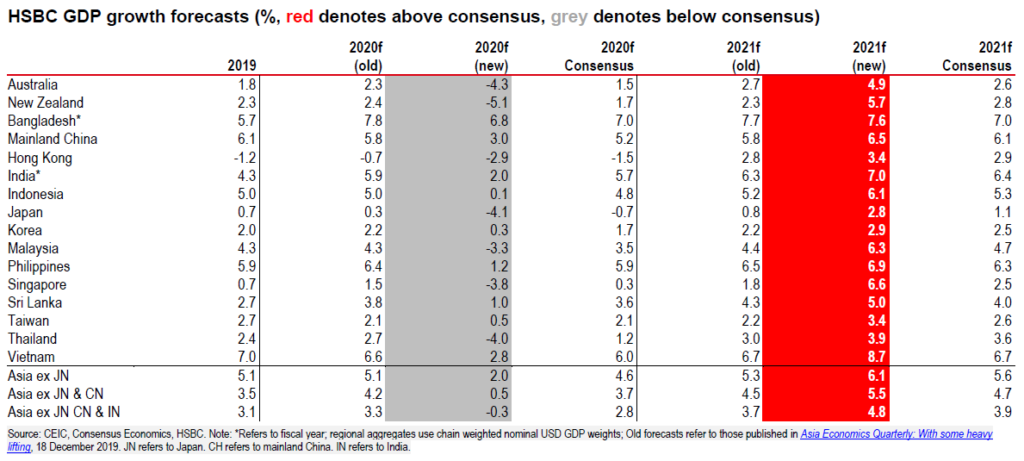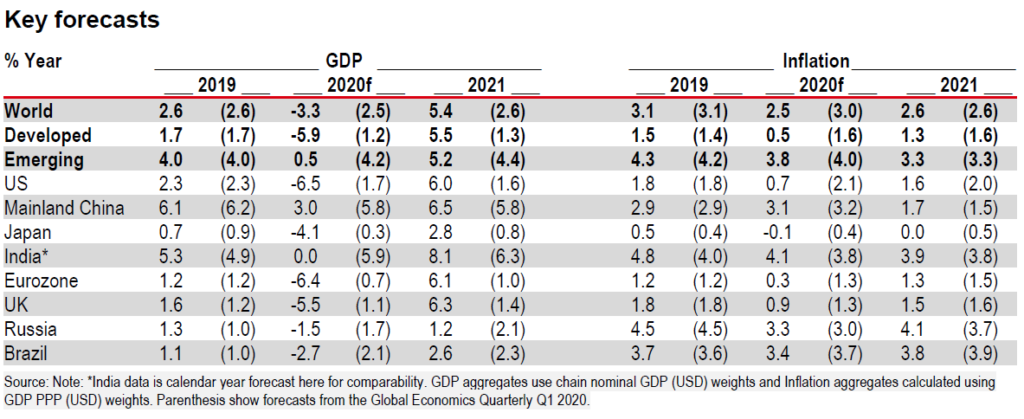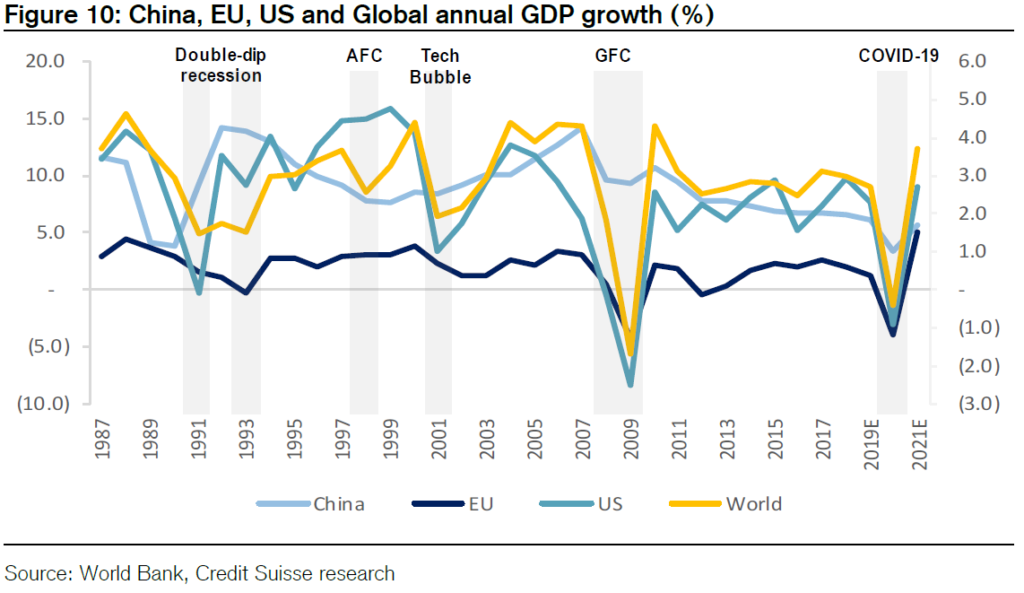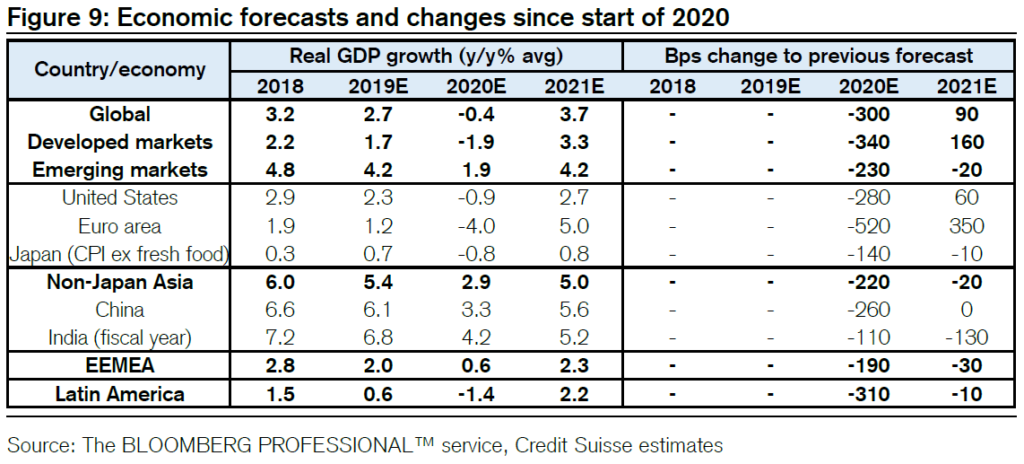
4-12 #HappyEaster: SK Hynix is currently accelerating the operation of the M16 fab; Redmi may consider IP68 for future products; etc.
Chipsets
Due to the impact of the coronavirus on semiconductor supply and demand, worldwide semiconductor revenue is forecast to decline 0.9% in 2020, according to Gartner. This is down from the previous quarter’s forecast of 12.5% growth. Overall, 2020 global semiconductor revenue has been reduced from the previous quarter’s forecast by USD55B, to USD415.4B. (Gartner, press)
According to IC Insights, the current worldwide 2020 IC market expectation of USD345.8B is USD39.0B less than the original forecast, which called for an 8% increase in 2020. IC Insights’ current baseline forecast for the IC market in 2020 calls for a 4% drop. Moreover, global GDP is now expected to post a decline in 2020 that is at least as deep as the 2.1% drop that was registered in 2009. (IC Insights, press)
Touch Display
According to Stone Partners, Samsung Display shipped 61.6M smartphone OLED panels during 1Q20 and captured 90.2% market share. On the other hand, rival brands EDO, Visionox, Tianma, and BOE were responsible for 4.9%, 4.5%, 0.4%, and 0.1% shipments, respectively, of the 68.3M OLED panels that were shipped during 1Q20. (GSM Arena, ET News, Sam Mobile)
Camera
According to Yole, the market size of 3D sensing technology in 2018 is USD3.743B, and it is forecast to be USD18.614B in 2023, with a CAGR of 38%. Among them, the fastest-growing segment is consumer electronics, mainly due to the application of several major phone vendors. In the field of consumer electronics, the market size in 2018 is USD1.81B, and it is expected to be USD13.77B in 2023, with a CAGR of more than 50%. (Orient Securities report)
According to IHS Markit, the global TOF sensor market size is USD370M in 2018, accounting for 33% of the entire 3D sensing market. In 2019, its market size increased by 35% year-on-year, and its market share reached USD500M, accounting for 40% about. Based on the various advantages of the TOF program, especially the cost advantage, it is expected that the market size of the TOF sensor will reach USD1.5B in 2022. (Orient Securities report)
Memory
According to Strategy Analytics, the global market for smartphone memory chips reached a combined value of USD39.3B in 2019. Samsung Memory has maintained its smartphone memory market share leadership with 47% revenue share in 2019, followed by SK Hynix and Micron. Samsung continued to strengthen its position in both NAND Flash and DRAM markets. The top-three vendors captured almost 84% revenue share in the global smartphone memory market in 2019. (Strategy Analytics, press, Laoyaoba)
SK Hynix is currently accelerating the operation of the M16 fab. SK Hynix plans to advance the construction of the M16 factory and equipment storage time, and the equipment is expected to be fully operational in 2021 after installation. The company plans to produce 10nm of DRAM in the M16 factory. In order to maximize productivity, SK Hynix will also introduce the extreme ultraviolet lithography (EUV) process. The initial 12” wafer capacity of M16 plant is 15,000-20,000. (Laoyaoba, China Flash Market)
Battery
Nomura raises their global EV battery capacity estimates for 2020-2025 by 10% mainly on the back of larger capacity announcements from China. For 2020, Nomura now expects total battery capacity of 532GWh, vs. 478GWh earlier. However, their figures are ~10% lower than SNE Research estimates. Nomura estimates global electric vehicle (EV) battery demand to rise by 45% pa over the next 3 years – to 177GWh / 441GWh in 2020 / 2023 (110GWh in 2019) – owing to the large number of EV roll-out during this period and a rise in EV penetration to 4.1% / 8.8% in 2020 / 2023 (2019: 2.5%). (Nomura report)
Material
Lu Weibing, vice president of Xiaomi Group, and general manager of Redmi has indicated that the company may consider IP68 for future products. (GizChina, Sohu, iFeng)
Connectivity
SoftBank Group says it will supply 300M face masks per month for Japan in a bid to ease the shortage. SoftBank Group says under a deal with Chinese firm BYD, it will supply 200M regular surgical masks and 100M advanced masks called N95 respirator per month starting from May 2020. BYD is a Chinese electric vehicle firm which also started mass-producing masks in Feb 2020 amid the spread of the new coronavirus. (CN Beta, Reuters, NHK)
Phones
Credit Suisse forecasts a 6.5% decline in smartphone units in 2020, lowering their previously reduced estimates (in early Mar 2020) by another 7%. Credit Suisse expects unit growth in 2021 now to be faster than their previous estimates, though absolute numbers would only go back to where they were in 2019, reflecting some of the global GDP growth dynamic. Despite lowering overall smartphone units by ~100M for 2020, Credit Suisse makes only a modest cut to their 5G unit estimates (~10.5M units). (Credit Suisse report)
PC Tablets
Credit Suisse is revising their PC forecast model and are lowering 2020 PC estimate to -7.5% YoY vs. -2.4% YoY previously, factoring in 3 major drivers: (1) supply disruption in China related to COVID-19, primarily impacting 1Q20; (2) demand destruction across both Commercial and Consumer given the near-term impact of stay-at-home measures, coupled with the lingering headwind from a softer macro environment; and (3) fading Win 7/Win 10 upgrades, particularly in 2H20. (Credit Suisse report)
Automotive
According to Oriental Securities, China’s commercial Internet of Vehicles market is expected to maintain a compound growth rate of 28% from 2018 to 2025. The market size will reach CNY80.6B in 2025, with the pre-installation market accounting for 37% and the post-installation market accounting for 63% (the Internet of Vehicles here only includes market that provides vehicle lifecycle management and fleet, logistics management and other services based on the front-mounted and rear-mounted Internet of Vehicles hardware, and does not include the related Pan-Internet of Vehicles market such as autonomous driving). (Orient Securities report)
According to Orient Securities, (1) Hardware terminal: It is estimated that the commercial vehicle networking hardware market will be CNY17.2B by 2025, and the output value will account for 21%. From basic vehicle networking equipment such as GPS, T-Box, and vehicle to ADAS, to upgrade of high-end intelligent network equipment; (2) Operation services (platform services): It is estimated that the commercial vehicle operation service market will be CNY36.7B by 2025, accounting for 45%, from vehicle positioning, fleet management, and safety / cost reduction solutions. (Orient Securities report)
Nomura forecasts global EV shipments at 3.6M / 12.9M units for 2020 / 2025, implying EV penetration at 4.1% / 13.0%. Previously, Nomura has projected EV shipments at 4.8M / 18.4M units for 2020 / 2025, with EV penetration of 5.0% / 17.7% each. (Nomura report)
Healthcare
China’s general health and wellness market stood at CNY8.6T in 2016, per Frost & Sullivan. This covers all healthcare services, and sales of pharmaceuticals, devices, nutrition products, maternal and infants products, and so on. Frost & Sullivan expects the overall market to reach CNY17T by 2022, and further expand to CNY27T by 2026. Within that, the “internet healthcare” industry only took a tiny fraction of CNY11B in 2016. Frost & Sullivan projects it to surpass CNY51B by 2022, almost five-fold the size in 2016. It expects growth to accelerate further afterwards to reach about CNY200B by 2026. (Morgan Stanley report)
Morgan Stanley has provided the industry mapping of key Chinese and global players by sub-segments. Morgan Stanley sees a handful of front runners with much larger user bases and relatively well-established business models. (Morgan Stanley report)
Gross merchandise value (GMV) transacted through B2C pharmaceutical e-commerce was CNY29.1B in 2017, just 1.8% of total pharmaceutical sales in China, or 7.1% of the retail pharmaceutical market. Frost & Sullivan forecasts the penetration ratio to reach 13.7% of total pharma sales, or 38.9% of retail pharma sales by 2022. This translates into a 61.9% CAGR in 2017-2022. (Morgan Stanley report)
Artificial Intelligence
Ferrum Health, a startup developing an AI patient safety platform to prevent medical errors, has announced that it secured USD9M in seed funding. According to CEO Pelu Tran, the plan is to use the capital infusion to refine the company’s product as Ferrum makes engineering, sales, and marketing hires. (VentureBeat, P&T Community, Yahoo)
Samsung’s S Voice will cease to operate as of 1 Jun 2020. Models still using S Voice include the Galaxy A3, A5, A7, A8, and A9, the Galaxy Note II, III, 4, 5, and FE, the Galaxy S III, S4, S5, and S6, as well as the Galaxy Note Pro 12.2, Galaxy W, Galaxy Tab 4, and Galaxy Tab S (1st gen). (CN Beta, GSM Arena, Sam Mobile)
Economy
New scenario analysis from Strategy Analytics indicates the COVID-19 induced 2020 Recession will disrupt Automotive, Consumer Electronics, Semiconductor, and IT infrastructure businesses worldwide before recovery in 2021. The new scenarios indicate that the damage from the worst economic cycle since the Great Depression, will cause both consumer and B2B businesses to suffer starting with an economic plunge of over 7% in real GDP (33% annualized) in major industrial economies in 2Q20. (Strategy Analytics, press)
The range of scenarios explored in ADB’s update suggest a global cost of USD2.0~4.1T, equivalent to 2.3%~4.8% of global GDP. The much higher estimate reflects its spread to Europe, the United States, and other major economies. Developing Asia including the PRC accounts for just 22%~36% of the total. Nevertheless, regional economies will be hit hard, with an impact on the PRC of close to 5% of GDP. The loss to the rest of developing Asia will be 1.0%~2.2% of GDP. (ADB report)
How the pandemic will evolve is unknown, leaving the outlook highly uncertain as the situation remains fluid. Based on information available to 20 Mar 2020, economic growth in the region is forecast to slow to 2.2% in 2020, with all subregions weakening. Assuming that the outbreak ends within 2020, growth will recover to 6.2% in 2021. Much of the expected decline in regional growth stems from a slowdown in the PRC, where growth is projected to plunge from 6.1% in 2019 to 2.3% in 2020 before rebounding above normal to 7.3% in 2021. (ADB report)
HSBC lays out the fiscal measures in more details. These, it should be noted, primarily focus on cushioning the impact from the growth shock, focusing in particular on employment support and help for SMEs. These packages, therefore, do not amount to a fiscal stimulus in the classic sense, for example spending on infrastructure with a high multiplier effect designed to drive up aggregate demand. (HSBC report)
HSBC has recently downgraded forecast for mainland China to 3% YoY growth in 2020, assuming an exceptional growth hit in 1H20, followed by a gradual recovery over 2H20. To achieve this, more monetary and fiscal easing is likely to be needed. The growth impulse for the rest of the world will, however, fall short of what the economy delivered in 2009, reflecting the changed nature of China’s economy, being less manufacturing and construction led, and a desire for more restrained calibration of corrective measures by officials. (HSBC report)
HSBC’s new forecasts envisage a contraction in global GDP of 3.3% (nominal GDP weights) in 2020, which compares with a fall of 2.1% in 2009. They generally assume that the lockdown measures, particularly in Europe and the US, are gradually lifted from May 2020 onwards, initially by easing social distancing measures (at least for the less vulnerable) and then gradually allowing more businesses to open up. (HSBC report)
Credit Suisse’s global growth forecast for 2020 is a full 300bp lower than it was at the start of the year and implies a decline in the global GDP in 2020 – the worst YoY growth that they have seen in the past 30+ years, except for the GFC. To put the forecast GDP declines in 2020 into context, Credit Suisse highlights previous years of GDP declines over the past 30 years. (Credit Suisse report)
